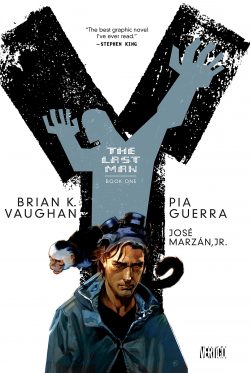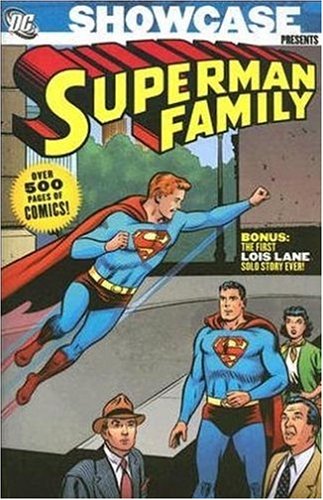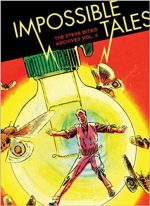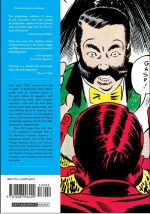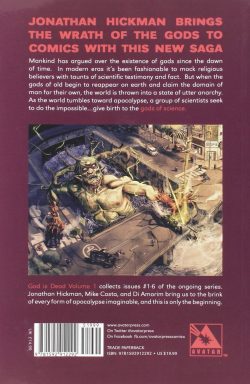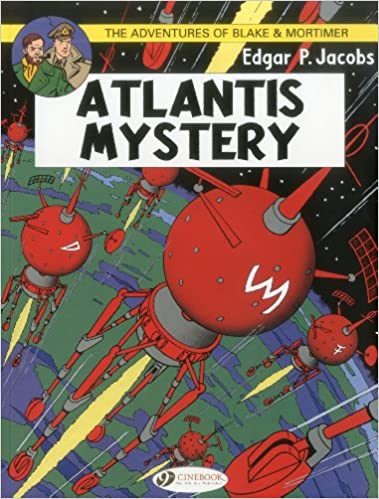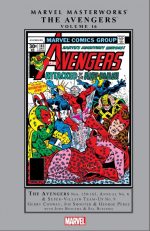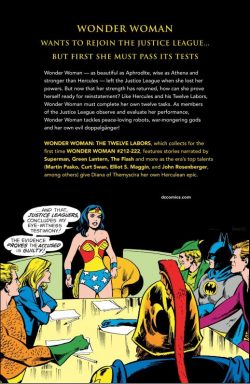
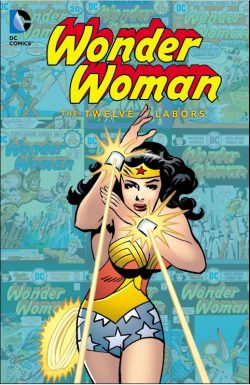
By Martin Pasko, Elliot S. Maggin, Cary Bates, Len Wein, Curt Swan, John Rosenberger, Irv Novick, Dick Dillin, Kurt Schaffenberger, Dick Giordano, Jose Delbo & various (DC Comics)
ISBN: 978-1-4012-3494-2 (PB)
The Princess of Paradise Island originally debuted as a special feature in All Star Comics #8 (December 1941), conceived by polygraph pioneer William Moulton Marston and illustrated by Harry G. Peter in a calculated attempt to offer girls a positive and forceful role model and – on forward-thinking Editor M.C. Gaines’ part – sell more comic books.
She catapulted into her own series and the cover-spot of new anthology title Sensation Comics a month later. An instant hit, the Amazing Amazon won her own eponymous supplemental title a few months later, cover-dated Summer 1942.
Once upon a time on a hidden island of immortal super-women, American aviator Steve Trevor of US Army Intelligence crashed to Earth. Near death, he was nursed back to health by young, impressionable Princess Diana.
Fearful of her besotted child’s growing obsession with the creature from a long-forgotten and madly violent world, Diana’s mother Queen Hippolyte revealed the hidden history of the Amazons: how they were seduced and betrayed by men but rescued by the goddess Aphrodite on condition that they forever isolated themselves from the mortal world and devoted their eternal lives to becoming ideal, perfect creatures.
However, with the planet in crisis, goddesses Athena and Aphrodite instructed Hippolyte to send an Amazon back with the American to fight for global freedom and liberty. She would be chosen by triumphing over all her sisters in a grand tournament. Although forbidden to compete, Diana clandestinely overcame all other candidates to become their emissary – Wonder Woman.
On arriving in the Land of the Free, she purchased the identity and credentials of lovelorn Army nurse Diana Prince, elegantly allowing the Amazing Amazon to stay close to Steve whilst enabling the heartsick but poverty-stricken care-worker to join her own fiancé in South America. Diana soon gained a position with Army Intelligence as secretary to General Darnell, further ensuring she would always be able to watch over her beloved. She little suspected that, although the painfully shallow Steve only had eyes for the dazzling Amazon superwoman, the General had fallen for the mousy yet supremely competent and capable Lieutenant Prince…
That set up enabled the Star-Spangled Siren to weather the vicissitudes of the notoriously transient comicbook marketplace and survive the end of the Golden Age of costumed heroes along with Superman, Batman and a few lucky second-stringers who inhabited the backs of their titles.
She soldiered on well into the Silver Age revival under the canny auspices of Robert Kanigher, Ross Andru & Mike Esposito, but by 1968 superhero comics were in decline again and publishers sought new ways to keep audiences interested as tastes – and American society – changed.
Back then, the entire industry depended on newsstand sales and if you weren’t popular, you died. Editor Jack Miller & Mike Sekowsky stepped up with a radical proposal and made a little bit of comic book history with the only female superhero to still have her own title in that turbulent marketplace.
The superbly eccentric art of Sekowsky had been a DC mainstay for nearly two decades, and he had also scored big with fans at Gold Key with Man from Uncle and at Tower Comics in T.H.U.N.D.E.R. Agents and war title Fight the Enemy! His unique take on the Justice League of America had cemented its overwhelming success, and in 1968 he began stretching himself further with a number of experimental, young-adult oriented projects.
Tapping into the teen zeitgeist with Easy Rider style drama Jason’s Quest proved ultimately unsuccessful, but with the Metal Men and the hopelessly outdated and moribund Wonder Woman he had much greater impact. Sekowsky would subsequently work the same magic with equally stalled icon Supergirl…
The big change came when the Amazons were compelled to leave our dimension, taking with them all their magic – including Wonder Woman’s powers and all her mystic weaponry. Now no more or less than human, she opted to stay on Earth permanently, assuming her own secret identity of Diana Prince, dedicated to fighting injustice as a mortal, very much in the manner of Emma Peel and Modesty Blaise.
Blind Buddhist monk I Ching rather rapidly trained her as a martial artist, and she soon became embroiled in the schemes of would-be world-conqueror Doctor Cyber. Most shockingly, her beloved Steve was branded a traitor and murdered…
Sekowsky’s root and branch overhaul offered a whole new kind of Wonder Woman, but as I’ve already said fashion ruled and, in a few years, without fanfare or warning, everything that had happened since Wonder Woman lost her powers was unwritten. Her mythical origins were revised and re-established as she returned to a world of immortals, gods, mythical monster and super-villains with a new nemesis: an African (or perhaps Hellenic?) American half-sister named Nubia…
Such an abrupt reversal had tongues wagging and heads spinning in fan circles. Had the series offended some shady “higher-ups†who didn’t want controversy or a shake-up of the status quo?
Probably not. Sales were never great even on the Sekowsky run and the most logical reason is probably Television.
The Amazon had been optioned as a series since the days of the Batman TV show in 1967, and by this time (1973) production work had begun on the original 1974 pilot featuring Cathy Lee Crosby. An abrupt return to the character most viewers would be familiar with from their own childhoods seems perfectly logical to me…
By the time Lynda Carter made the concept work in 1975, Wonder Woman was once again “Stronger than Hercules, swifter than Mercury and more beautiful than Aphroditeâ€â€¦
But as Diana returned to mainstream DC continuity, the readers and fans expected her to fully reintegrate, leading to this early and impressive example of a comics miniseries which ran in Wonder Woman #212 through 222 (cover-dates July 1974 – March 1976), detailing how the Amazing Amazon rejoined the JLA.
Scripter Len Wein and artists Curt Swan & Tex Blaisdell got the ball rolling with ‘The Man Who Mastered Women!’ as our Hellenic Hellion thwarts a terrorist attack at New York’s United Nations building… where Diana Prince now works as a translator. In the aftermath she surprisingly meets old friend Clark Kent.
Over the course of the conversation she realises her memories have been tampered with and suddenly understands why her JLA colleagues haven’t called her to any meetings… She had resigned years ago…
Although her former comrades beg her to re-enlist, she declines, fearing her memory lapses might endanger the team and the world. After much insistent pleading, she relents enough to suggest the League should covertly monitor her next dozen major cases – in the manner of Hercules‘ twelve legendary tests – until she proves herself competent and worthy, for her own peace of mind, if not the JLA’s…
Once they grudgingly agree, she leaves and Superman begins the surveillance, observing her flying to Paradise Island in her Invisible Plane. Correctly deducing she has been subjected to Amazonian selective memory manipulation, Diana confronts her mother and learns of her time as a mere mortal… and of Steve’s death.
Although the past has been removed by her well-meaning Amazon sisters, Diana now demands that every recollection excised be returned…
Back in Man’s World, a crisis is already brewing as costumed crazy The Cavalier exerts his uncanny influence over women to control female Heads of State. Ultimately, however, his powers prove ineffectual over Wonder Woman…
As a result of that case, Diana Prince changes jobs, going to work as a troubleshooter for dashing Morgan Tracy at the UN Crisis Bureau, and her first mission isn’t long in coming…
Wonder Woman #213 was crafted by Cary Bates, Irv Novick & Blaisdell, detailing how an alien robot removes all aggression from humanity in one stroke. As the Flash helplessly observes, however, ‘The War-No-More Machine!’ also quashes all bravery, determination, confidence and capability. The species faced imminent – if long and drawn out – extinction.
Happily, Diana, a teenaged girl and a murderous criminal are all somehow immune to the invader’s influence…
Elliot S. Maggin, Swan & Phil Zupa then disclose Green Lantern Hal Jordan‘s undercover observations after a lost Amazon gem in unwitting, unscrupulous hands almost starts World War III and the Princess of Power must avert nuclear holocaust triggered by a ‘Wish Upon a Star!’
The superb and vastly undervalued John Rosenberger pencilled Bates’ tale of the ‘Amazon Attack Against Atlantis’ (inked by Vince Colletta) as Aquaman watches Wonder Woman unravel a baroque and barbaric plot by Mars, God of War to set Earth’s two most advanced nations at each throats, after which #216 finds Black Canary uncovering the Amazon Sisterhood’s greatest secret in ‘Paradise in Peril!’ (Maggin, Rosenberger & Colletta).
The tale concerns an obsessed multi-millionaire risking everything – including possibly the collapse of civilisation – to uncover exactly what would happen if a man sets foot upon the hidden Island of the Amazons…
One of Wonder Woman’s oldest foes resurfaces in ‘The Day Time Broke Loose!’ (Maggin, Dick Dillin & Colletta) and Green Arrow is caught in the crossfire as the Duke of Deception attacks the UN with temporally torturous images and hallucinations designed to create madness and death on a global scale.
Produced by Martin Pasko & Kurt Schaffenberger, issue #218 offers two short complete tales. Firstly Red Tornado reports on the ‘Revolt of the Wonder Weapons’ as an influential astrologer uses mind-control techniques to gain power and accidentally undermine Diana’s arsenal, after which The Phantom Stranger stealthily witnesses her foil a mystic plot by sorcerer Felix Faust which animates and enrages the Statue of Liberty in ‘Give Her Liberty – and Give Her Death!’
This was a time when feminism was finally making inroads into American culture and Pasko, Swan & Colletta slyly tipped their hats to the burgeoning movement in a wry and fanciful sci-fi thriller. Thus, WW #219 sees Diana preventing a vile incursion by the dominating males of Xro, a ‘World of Enslaved Women!’, with stretchable sleuth Elongated Man covertly traversing the parallel dimensions in Wonder Woman’s wake.
With the epic endeavour almost ended, scripter Pasko added a patina of mystery to the affair as the Atom watches Diana tackle ‘The Man Who Wiped Out Time!’ Illustrated by Dick Giordano, Wonder Woman #220 found temporal bandit Chronos eradicating New York’s ability to discern time and time pieces: a plot foiled with style and brilliance by the on-form, in-time Power Princess.
The only problem was that during that entire exacting episode Hawkman had been simultaneously watching Diana tackle another potential disaster hundreds of miles away…
The Feathered Fury’s report details how Crisis Bureau operative Diana Prince was targeted by Dr. Cyber and Professor Moon – old enemies from her powerless period – who combine a hunger for vengeance with a plan to steal a UN-controlled chemical weapon in ‘The Fiend with the Face of Glass’ (illustrated by Swan & Colletta).
How she could be in two places simultaneously was revealed by Batman, who wraps up the twelve trials in ‘Will the Real Wonder Woman Please… Stand Up Drop Dead!’ (illustrated by Jose Delbo & Blaisdell), detailing how a beloved children’s entertainment icon has been subverted into a monster feeding off people whilst replacing them with perfect duplicates…
With covers by Bob Oksner, Nick Cardy, Mike Grell, Dick Giordano & Ernie Chan, this is a spectacular slice of pure, uncomplicated, all ages superhero action/adventure starring one of comics’ true all stars.
Stuffed with stunning art and witty, beguiling stories, here is Wonder Woman at her most welcoming in a timeless, pivotal classic of the medium: one that still provides astounding amounts of fun and thrills for anyone interested in a grand old time.
© 1974, 1975, 1976, 2012 DC Comics. All Rights Reserved.

